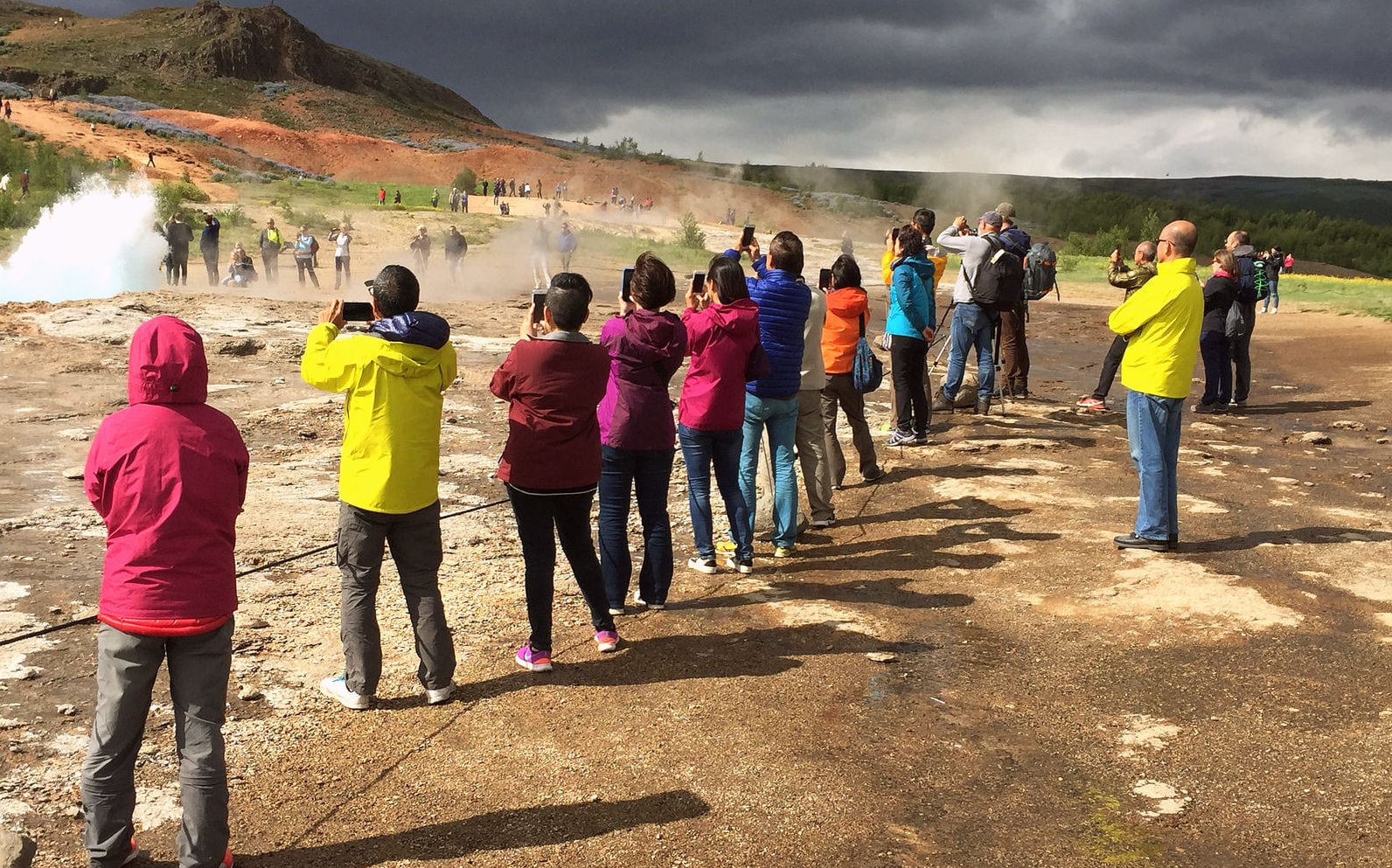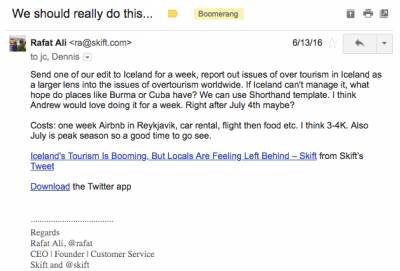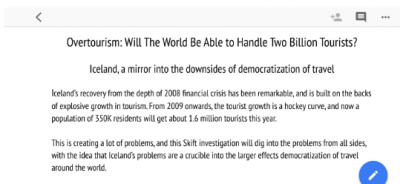Skift Take
We came up with “overtourism,” a simple portmanteau to appeal to people's baser instincts with an element of alarm and fear in it. That is the biggest reason why the term and its exploration by everyone has caught on.
Overtourism is a word that I inadvertently coined on June 14, 2016. It happened as it usually does for me when I work out concepts in my head: with an email to the two people I have been working with since we started Skift: Jason and Dennis. I quickly created a Google Doc outlining what I had in mind and shared it internally.
This was a continuation of the previous discussion we had in office with the editorial team about the democratization of global travel and what affect it had on the world, and who were the winners and losers.
That was also a time soon after UNWTO declared that the tourists traveling globally had crossed the one billion mark. It was also the seminal year when the Chinese travelers became the biggest group of outbound tourists in the world, crossing the 100 million mark annually.
There was also an ongoing parallel conversation happening at Skift amongst our editorial team on sustainable travel and our role in covering it. We had stayed away from the phrase “sustainability” since the start, because it was a phrase that had been in usage in travel for 20 years with little or no resonance in the larger travel industry, beyond the 101 basics everyone does.
The industry organizations like UNWTO and WTTC and other such stasis-by-consensus bodies had been using it forever, to be brought out in conferences and annual corporate social responsibility (read PR) efforts when needed. If this was the case for the industry insiders, imagine what happened when you threw around sustainability to the travel consumers: everyone’s eyes would glaze over. In other words, no one would give a shit.
Skift being Skift, we started to think through new ways of approaching the intersection of global growth of tourism and the responsibility of the travel industry, the world’s largest, to manage this growth.
We have championed two other “rallying cries” since our start: 1) Travel is the world’s largest industry, let’s start acting like it. 2) Travel is now the geopolitical center of the world, deal with it!
These were the large narrative arcs that we were working with, after three years into the Skift journey.
Why Iceland?
I came up with “Overtourism,” a simple portmanteau to appeal to people’s baser instincts with an element of alarm and fear in it. That is precisely the reason why it has caught on like fire since then, because it is self explanatory and alarmist in intent.
As for why we chose Iceland as the mirror to look at overtourism in the first place, it had to do with two of my visits to Iceland. The first was in the summer of 2010, when I left my first company paidContent (after selling it to Guardian Media Group in 2008) and went on my sabbatical travels that continued on for two years.
The first place I went to was Iceland, a week after that volcano had fully stopped, and saw the effects of it and the collapse of Iceland’s economy post-financial crisis, as well the decimation of its travel economy, at least temporarily.
The second moment was our first company retreat at Skift: we went to Iceland in the summer of 2014, mostly as a fun trip but also as a way for us to understand a lot of the consumer travel trends that we were writing about that we saw were converging in Iceland. We visited the travel industry people across all spectrums of Icelandic travel and saw the boom starting to happen as a result of the freak-exposure due to the global-halting volcano.
I have been to Iceland every year since and continued to see the volcanic growth — pun intended — of the travel economy. The reorienting of a small country, each and every part of it, to cater to the tourists was breathtaking and disorienting to watch in real time.
How did it go from this to this, in a very short period of five years?
Thus was born our deep dive into Iceland as a mirror to the issues underlying issues of overtourism. The need to manage growth the right way, which then has downstream effects on sustainable practices in growth in hospitality and tourism. We think the business case for understanding and managing overtourism is better than appealing to the altruistic part of companies and executives.
Defining Overtourism
After our reporter Andrew Sheivachman went to Iceland and dug deep into the booming tourism economy and the issues of overtourism there, the end result that launched on August 16, 2016 has become a seminal piece in the history of travel business reporting, quoted thousands of times and, of course, defining overtourism for the first time.
I wrote the intro to the deep dive, and defined overtourism for the first time, publicly:
“We are coining a new term, “Overtourism”, as a new construct to look at potential hazards to popular destinations worldwide, as the dynamic forces that power tourism often inflict unavoidable negative consequences if not managed well. In some countries, this can lead to a decline in tourism as a sustainable framework is never put into place for coping with the economic, environmental, and sociocultural effects of tourism. The impact on local residents cannot be understated either.
As the world moves towards two billion travelers worldwide in the next few years, are countries and their infrastructure ready for the deluge? Are the people and their cultures resilient enough to withstand the flood of overtourism?”
The reaction to the Iceland piece was phenomenal, as much for the depth of reporting and the analysis behind the reasons, as it was for finally putting a framework on the global travel boom. It was the same boom everybody in the travel ecosystem saw and was worried about, but just didn’t have the right lens to look at before the overtourism construct.
Since then, Skift’s journalists continued our deep reporting on overtourism in dozens of stories from all parts of the world, and were also the first ones to start asking the right questions about the potential solutions to overtourism. Last year we came up with the first solutions framework to overtourism, describing five ways in which destinations could — and have started to — manage, solve and even avoid overtourism in destinations.
Since our initial deep dive into Iceland’s struggle, Skift has tracked the growing global awareness of overtourism relentlessly around the world. Venice, Amsterdam, New York City, and Barcelona are just a few of the flashpoints we’ve examined, along with looks at how the global rise of Airbnb has helped the global wave of overtourism. We’ve never shied away from asking tourism executives about how they’ve contributed to the problem, and what can be done to help tourism growth become more sustainable in hot destinations. We’ve even produced a documentary short examining Barcelona’s backlash to the trend.
More recently, Skift has looked at measures cities can take earlier to prevent being paralyzed by overtourism, such as Lisbon. And how others, like Sofia, can help chart the future for other destinations in emerging regions.
Everyone Else Jumps On Overtourism
As a small and then nascent company, we weren’t expecting overtourism, the word we coined, to catch on the way it did, even if we knew the alarmism inherent in it would appeal to everyone, including mainstream media.
Thousands of media stories have been written on overtourism since, in every conceivable language, most of them reactionary and mildly tone-deaf “OMG-look-at-these-hordes-of-Chinese-tourists” in nature. There have been strains of neo-isolationism in an age of Brexit, Trump, and immigration crisis in Europe. Concerns about quality of life issues as a result of a phenomena like Airbnb landing in midst already overcrowded cities has also been a prevent theme. The dumping of thousands and thousands of cruise tourists in cities around the world, a relatively older debate, also came under the rubric of overtourism.
Thus was also born the mini-economy around the “experts” attempting to define overtourism — nevermind our first definition of it.
The hashtag #overtourism was born and dozens of tourism consultants, consultancies and wannabe gurus jumped on it. Tourism professors and academics finally had something new to talk about since BRICS became a term. Dozens of papers have been public in academic journals and PhDs are in progress around overtourism.
Also born were dozens of panels at tourism and development conferences around the world, and even the glacially active UNWTO started talking about it at their conferences. WTTC, that old boys corporate club of travel sector, even commissioned McKinsey (McKinsey!) to come out with what they billed as the first definitive study on overtourism, 18 months after we had coined the term and explored in dozens of stories since. Tourism ministers around the world starting talking about it in their policy effort. It even created a sub-genre of derivative documentaries exploring overtourism.
The summer of 2017 was dubbed the Summer of Overtourism, especially in Europe, as a confluence of global factors led to the remarkable growth in the world’s largest tourism continent.
At the end of 2017, The Telegraph declared “overtourism” as the word of the year, outlining our definition of term and rhetoric that had developed around it since we coined it.
While we have watched this all along with some bemusement— and proud of the impact our journalists and their reporting has on this world— it seems like everyone wants to be a “thought leader” on overtourism.
Meanwhile the two simple lines which I wrote in the first few lines I wrote in overtourism intro doc — “Will The World Be Able to Handle Two Billion Tourists? Overtourism as a mirror into the effects of democratization of global travel”— still has a lot to explore, from all possible angles, societal, cultural, economic and developmental.
What Next After Overtourism
Every city with a strong tourism economy has always attempted to diversify visitor spending and push incoming travelers beyond the most-frequented travel hotspots. With the rise of overtourism, however, tourism boards are now collaborating much more intentionally with their local governments and economic development agencies to create new travel experiences in underserved areas and incorporate new businesses into the regional tourism mix, what we have called the clash of cities’ visitor and local economies.
These visitor dispersal strategies are also closely aligned with initiatives to build destination loyalty and extend average length of stay. By developing new travel product — leisure and business — away from high-volume tourist traffic, cities are also creating new reasons for past visitors to return to explore what’s deemed as more “authentic” travel destinations.
To increase visitor dispersal, cities and countries are promoting local culinary and cultural tourism in partnership with regional public and private organizations. For these initiatives to deliver a positive return on investment, it’s critical for tourism organizations to work effectively with regional governments and economic development groups to secure the necessary public funds and business community buy-in.
In the meetings and events sector, destinations are working more intentionally to attract conferences that align with their priority growth sectors in advanced industries, ranging from clean tech to life sciences, to build a more meaningful business travel sector that has long term effects on the local economies.
While not a new concept, public-private partnerships are becoming a lot more intentional and structured to deliver greater and more measurable impacts. These are the next frontiers of overtourism Skift is exploring in the coming days.
Skift Business Travel Editor Andrew Sheivachman and SkiftX Executive Editor Greg Oates contributed to this report.
The Daily Newsletter
Our daily coverage of the global travel industry. Written by editors and analysts from across Skift’s brands.
Have a confidential tip for Skift? Get in touch
Tags: overtourism
Photo credit: Tourists watching tourists watching the geyser at Geysir, in Iceland. Jen Proctor / Flickr


